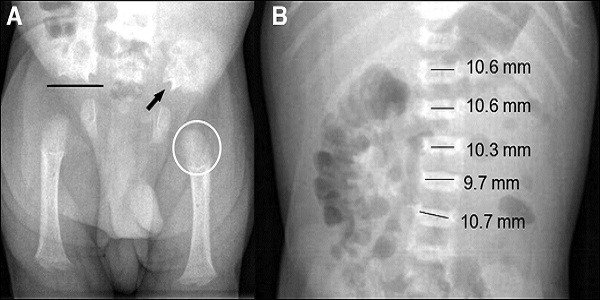Achondroplasia

Achondroplasia is a bone growth disorder that causes disproportionate dwarfism. As dwarfism is defined as a condition of excessively short stature in adulthood.
People with this disease are short, with a normal-sized torso and short limbs. This is the most common type of disproportionate dwarfism.
The disease occurs in approximately 1 in 25,000 live births, affecting both sexes equally.
What are the symptoms?
Affected children usually develop normally intellectually. With them, the anomalies are only physical.
When a child is born with this disorder, they will most likely later develop:
• Short stature – significantly below the average level for age and sex;
• Short arms and legs – especially upper arms and thighs compared to body height;
• Disproportionately large head compared to the body;
• An unusually large forehead;
• Underdevelopment of the area in the middle part of the face – between the forehead and the upper jaw;
• Short fingers such as the thumb and middle fingers are too far apart;
Health problems in babies and young children are most often expressed in:
• Decreased muscle tone, which can cause the child to walk late and delay the acquisition of other motor skills;
• Apnea – short periods when breathing slows down or stops;
• Hydrocephalus – accumulation of fluid in the brain;
Spinal stenosis – narrowing of the spinal canal, which can lead to compression of the spinal cord;
In older children and adults the clinical manifestations of the disease are:
• Difficulty bending the elbows;
• Causeless obesity;
• Frequent ear infections due to narrowing of the ear canals;
• Their feet lean forward;
• Develop an abnormal curvature of the spine, referred to as kyphosis or lordosis;
• Have new or more severe spinal stenosis;
What are the causes?
In early fetal development, most of its skeleton is made up of cartilage. Cartilage usually turns into bone.
But in people with dwarfism, much of the cartilage fails to convert, caused by mutations in the FGFR3 gene.
The FGFR3 gene instructs the body to produce a protein necessary for bone growth and maintenance.
But gene mutations cause the protein to become overactive, preventing normal skeletal development.
The average height of affected people in adulthood is 1.34 m for men and 1.25 m for women. In rare cases, sufferers of the disease reach a height of over 1.52 m.
Achondroplasia treatment
There is no cure or specific treatment for the disease. If any complications arise then the GP will be able to give you a specific answer.
For example, antibiotics are prescribed for ear infections and surgery is imperative for severe cases of the spine.
Some doctors use growth hormones to speed up a child’s bone growth, but their long-term effects on growth have not yet been established.
However, there is a method to increase height by performing an operation in which devices are inserted to gradually move the long bones apart.
But the surgical intervention requires breaking the long bones of the legs and arms, and they are moved apart with the help of the apparatus, and when the fractures begin to heal, the bones increase in size.
As the device moves at a speed that is sufficient to form new bone mass and thus achieve an increase in the size of the limbs and, accordingly, in the height of the body.



